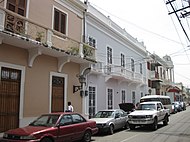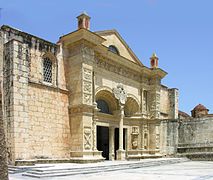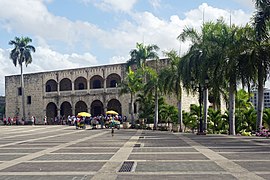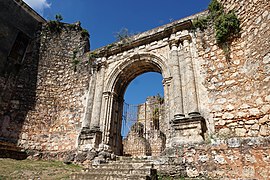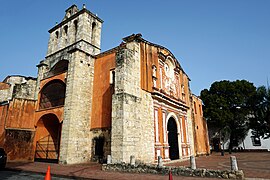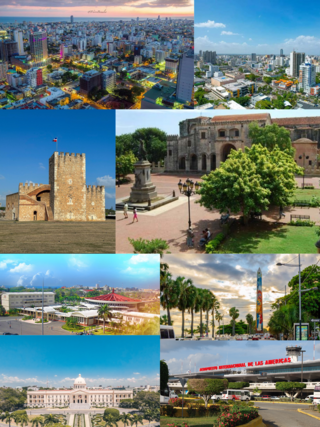
Santo Domingo, once known as Santo Domingo de Guzmán, known as Ciudad Trujillo between 1936 and 1961, is the capital and largest city of the Dominican Republic and the largest metropolitan area in the Caribbean by population. As of 2022, the city and immediate surrounding area had a population of 1,029,110 while the total population is 3,798,699 when including Greater Santo Domingo. The city is coterminous with the boundaries of the Distrito Nacional, itself bordered on three sides by Santo Domingo Province.

Old San Juan is a historic district located at the "northwest triangle" of the islet of San Juan in San Juan. Its area roughly correlates to the Ballajá, Catedral, Marina, Mercado, San Cristóbal, and San Francisco sub-barrios (sub-districts) of barrio San Juan Antiguo in the municipality of San Juan, Puerto Rico.

The Captaincy General of Santo Domingo was the first Capitancy in the New World, established by Spain in 1492 on the island of Hispaniola. The Capitancy, under the jurisdiction of the Real Audiencia of Santo Domingo, was granted administrative powers over the Spanish possessions in the Caribbean and most of its mainland coasts, making Santo Domingo the principal political entity of the early colonial period.

The Ozama Fortress, also formerly known as the city wall's Homage tower, is one of the surviving sections of the Walls of Santo Domingo, which is recognized by UNESCO as being the oldest military construction of European origin in the Americas. It was built between 1502-1508 by the Spanish at the entrance to Santo Domingo's Ciudad Colonial, Dominican Republic, and overlooking the Ozama River. Named after this river, the castle, also referred to as "La Fortaleza" or "The Fortress". It was declared by UNESCO as a World Heritage Site, together with the other historical monuments of the Ciudad Colonial.

The Alcázar de Colón, or Columbus Alcazar, is the first fortified European palace built in the Americas. Located in the colonial area of Santo Domingo, Dominican Republic, it forms part of the Ciudad Colonial, a UNESCO World Heritage Site. Constructed between 1510 and 1514, the palace is predominantly Gothic with Renaissance influences.

The Museo de las Casas Reales is one of the important cultural monuments built during the colonial era in Hispaniola, now the Dominican Republic. It is located in the Colonial district of Santo Domingo.

Miguel D. Mena is a Dominican writer, poet, essayist and publisher. He studied sociology in the Autonomous University of Santo Domingo, where he graduated in 1986 with the thesis Ciudad, espacio y poder en Republica Dominicanca. He continued his research on the city of Santo Domingo in Germany, where he has been living since 1990. His PhD from the Free University of Berlin has been recently published under the title: Iglesia, Espacio y Poder: Santo Domingo (1498–1521) Experiencia Fundacional del Nuevo Mundo. He has also written a collections of essays about the urban cuestion in the Dominican Republic and hundred of articles for newspapers and magazines about contemporary aspects of the Dominican capital. He has also written extensively about Dominican literature and especially about Vanguardism in the Dominican literature. He has been one of the leading figures in independent publishing since the mid-1980s in Dominican Republic. He is now at the head of “Cielonaranja Ediciones”

The Hospital San Nicolás de Bari is a preserved hospital ruin, and it was recognized by UNESCO for being the oldest hospital built in the Americas. Construction began in 1503 in Santo Domingo, Dominican Republic, at the behest of governor Nicolás de Ovando. This grand project was in keeping with the desire to emulate European princely courts, and looked to Renaissance Italy for inspiration. At the time of its completion, the wards could accommodate up to 70 patients, comparable to the most advanced churches of Rome. It is likely that the model for the Hospital de San Nicolás was the large Ospedale di Santo Spirito in Sassia in Rome. The complex forms part of the Colonial Zone of Santo Domingo World Heritage Site.

The Reales Atarazanas is a waterside building that housed the shipyards, warehouses, customs house and tax offices of the old port of Santo Domingo, Dominican Republic. It was the property of the Spanish Crown. Begun in 1509, the Atarazanas is the oldest building of its type still standing in America, and one of a handful remaining in the Spanish world, amongst which are the Atarazanas Reales de Barcelona, in Barcelona, the Atarazanas Reales de Sevilla, in Seville, the Atarazanas del Grao in Valencia and the Royal Dockyard in Havana.

La Puerta del Conde was the main entrance to the fortified city of Santo Domingo, named to honor Governor Captain-General Bernardino de Meneses Bracamonte y Zapata, 1st Count of Peñalva, who during his tenure saved the city from a siege in 1655 by Englishmen General Robert Venables and Admiral William Penn amid the Third Anglo-Spanish War.

Parque Colón, or Columbus Park, is the central square of the Ciudad Colonial historic district of Santo Domingo, Dominican Republic. In its center stands a statue of Christopher Columbus, in whose honor the square was renamed in 1887. Previously the square was known as Plaza Mayor.
The following is a timeline of the history of the city of Santo Domingo in the Dominican Republic.
The Walls del Arrabal were the third in a set of five walls built around Madrid, now the capital of Spain. There are no remaining ruins of the Walls del Arrabal, leaving some debate as to their extent and the period of their construction. It is possible that the walls were built as early as the 12th century, however they were most likely constructed in 1438. The walls may have been intended to protect people against the plagues that ravaged the city at the time. The walls united the urbanized suburbs of the city and prevented entry of the infected.

Old Town of Cáceres is a historic walled city in Cáceres, Spain.
Rosa Altagracia Eulogia Gómez Arias was a Dominican socialite who was the First Lady of the Dominican Republic from 2000 until 2004 and the wife of President Hipólito Mejía.
Lisandro José Macarulla Tavárez is a businessman and entrepreneurial leader from the Dominican Republic.

The Plaza de España, also known as the Plaza de la Hispanidad, is a public square located in the historic district of Ciudad Colonial, Santo Domingo, Dominican Republic. To its north lies the historic Alcázar de Colón, dating back to 1514, and to the south, the Museo de las Casas Reales, built in 1511.












